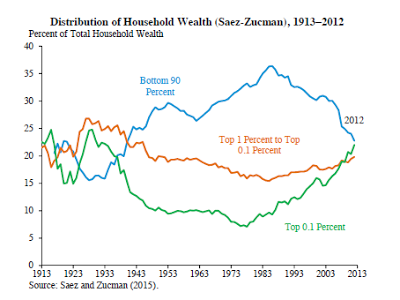Summary:
This is a bit old. The Economic Report of the President was published a while ago. I just was looking recently, essentially because it has a chapter on the 70th anniversary of the Council of Economic Advisers (CEA). The report discusses the role of Leon Keyserling, the second chair of the CEA, but the most relevant one in the early period, who, like Eccles at the Fed, tends to be a relatively underestimated and forgotten influence on the rise of Keynesian economics (that's in this chapter). That is enough to make this Report worth reading.But the first chapter (on inclusive growth) tackles the issue of inequality, and not just income, but wealth too. Below the shares in wealth distribution for the top 0.1%, 1% and the bottom 90%. It's very clear that while the New Deal compressed the shares of the top groups, the Reagan Revolution has completely reversed the earlier achievements. And it is also clear that inequality is important also at the top, since the 0.1% do so much better than the 1%. And the early Keynesians like Keyserling and Eccles were partially responsible for the improvement in wealth and income equality back then.
Topics:
Matias Vernengo considers the following as important: CEA, Eccles, Keyserling, Wealth Inequality
This could be interesting, too:
This is a bit old. The Economic Report of the President was published a while ago. I just was looking recently, essentially because it has a chapter on the 70th anniversary of the Council of Economic Advisers (CEA). The report discusses the role of Leon Keyserling, the second chair of the CEA, but the most relevant one in the early period, who, like Eccles at the Fed, tends to be a relatively underestimated and forgotten influence on the rise of Keynesian economics (that's in this chapter). That is enough to make this Report worth reading.But the first chapter (on inclusive growth) tackles the issue of inequality, and not just income, but wealth too. Below the shares in wealth distribution for the top 0.1%, 1% and the bottom 90%. It's very clear that while the New Deal compressed the shares of the top groups, the Reagan Revolution has completely reversed the earlier achievements. And it is also clear that inequality is important also at the top, since the 0.1% do so much better than the 1%. And the early Keynesians like Keyserling and Eccles were partially responsible for the improvement in wealth and income equality back then.
Topics:
Matias Vernengo considers the following as important: CEA, Eccles, Keyserling, Wealth Inequality
This could be interesting, too:
Matias Vernengo writes Gatekeepers and herd behavior: On Tooze and the radicalization of Krugman
Mike Norman writes Austin Clemens — No one measure of inequality tells the whole story–income, wealth, and consumption should be considered together
Matias Vernengo writes On Eccles and QE in the 1930s
Matias Vernengo writes Lord Eatwell in the Financial Times
This is a bit old. The Economic Report of the President was published a while ago. I just was looking recently, essentially because it has a chapter on the 70th anniversary of the Council of Economic Advisers (CEA). The report discusses the role of Leon Keyserling, the second chair of the CEA, but the most relevant one in the early period, who, like Eccles at the Fed, tends to be a relatively underestimated and forgotten influence on the rise of Keynesian economics (that's in this chapter). That is enough to make this Report worth reading.
But the first chapter (on inclusive growth) tackles the issue of inequality, and not just income, but wealth too. Below the shares in wealth distribution for the top 0.1%, 1% and the bottom 90%.

